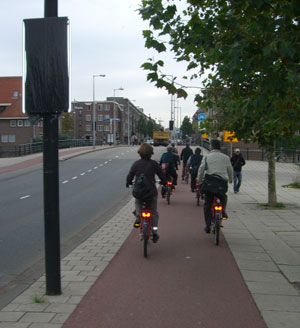Seattle’s on-again, off-again relationship with cycle tracks is back off again. But this time the issue is semantics.
In June the city’s Department of Transportation, affectionately known as SDOT, proposed putting cycle tracks on Dexter Avenue. That plan fell through for a number of reasons that should have been gobsmackingly obvious before SDOT announced it, but whatever. Instead buffered bike lanes will grace Dexter.
Lo and behold, cycle tracks re–emerged at the Seattle Bicycle Advisory Board’s September monthly meeting. The plan as reported by Publicola was to install them along Linden Avenue North between North 145th and 128th Streets as part of the Interurban bike route. “SDOT Proposes City’s First Cycle Track (Again),” the headline reads.
But when BikeIntelligencer contacted SDOT, project manager Connie Zimmerman informed us that the term “cycle tracks” did not apply to the Linden project. Instead, the project officially involves buffered bike lanes. (Indeed, there is no mention of the term on the official Web page.)
That raises the question, what’s the difference between cycle tracks and buffered bike lanes?
As near as we can tell, the answer is that they’re spelled differently.
From a strict-constructionist linguistic standpoint, they are different — or at least once were. Cycle tracks technically refer to bike lanes separated from motorized vehicles by a physical barrier. In Europe that can mean everything from ramps to concrete medians. In Portland all it means is striped pavement.
Although it’s come into popular use only in recent bike-boom years in the U.S., the term actually originated nearly a century ago in England — which, after due deliberation and consultation with real bike riders, wound up rejecting the whole notion. Its current popularity apparently stems from the success of separated bicycle facilities in Denmark and the Netherlands — although they call them, prosaically enough, “paths.”
Under the classic definition, the Linden bike lanes do not qualify as cycle tracks. They’re separated from vehicles, but only by space (a buffer) — painted stripes on the pavement. Our video below shows recently installed buffered lanes on North 130th Street.
Unfortunately, a lot of newer bike-lane installations that do not meet the strict definition of cycle tracks have come to be lumped under the term. Somehow cycle tracks sounds cooler than bike lanes (which may explain Portland’s misuse). Silly as it may be, a project is likelier to get taken more seriously as “cycle tracks” than the more pedestrian (pun unavoidable) sounding bike lanes.
Whatever its cachet, we at BikeIntelligencer hate the term cycle tracks. It sounds like bikes sharing railroad right of way. Or what track bikes ride on.
As Zimmerman put it, cycle tracks “is a generic word like food. It could mean a variety of things.”
It’s unintuitive, it’s mushy, and it’s lost all meaning. We applaud SDOT for backing off the designation on Linden. And if the city never implements something called “cycle tracks,” we’ll be fine with that too.


interesting you bring this up as i’ve been having similar conversations with people at the Mayor’s office and other places here in Portland.
I think that language and labels are very important.
in transportation wonk terms, a cycle track is thought of as a physically separated facility at a minimum and usually has its own signalization and/or separate grade/pavers, etc..
american politicians and their staff like to use the term because they are aspiring to be like the description above. here in portland, our cycle track really isn’t one. it’s basically a curbside bike lane with a buffer that’s separated by parked cars. In NYC they’ve got an almost identical configuration they — very accurately in my opinion — call a “parking protected bicycle path.”
the reason these words are important is because if/when our city does go big and tries to put in a real cycle track, people will think of the existing, fake cycle track and won’t have the needed enthusiasm/understanding to get excited enough to make an actual real one a reality.
clear? thanks for the post paul, i plan a story on this next week.
The revamp of Broadway as part of the First Hill streetcar line includes a cycle track separated from the main traffic lanes by a curb and parking.
The recent road diet installations are an affront to all citizens of Seattle. I bike and I drive. The lame way that the roadstriping has been done really tears me up. Giving barely six feet for parked cars is an endangerment to bicycle riders. The mirrors are overhanging even for a Corolla. Let alone a truck that will not fit into this BS excuse.
How about some real bike lanes? Like ones this article is speaking?
As a bicyclist, I go out of my way to not become a statistic. As a driver, I am aghast at the lack of thought that has gone into the striping!
More real bike corridors, less inanity by the SDOT!